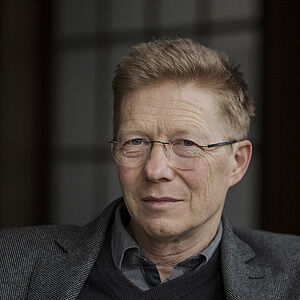
Giovanni Galizia, PhD
Professor für Zoologie und Neurobiologie
Universität Konstanz
Geboren 1963 in Rom
Studium der Biologie an der Freien Universität Berlin und der Zoologie an der University of Cambridge
Arbeitsvorhaben
Olfactory Coding in the Brain
Olfaction is far from understood—not in humans, and not in any animal species. The structure of neural networks is quite similar across many species in the an¬imal kingdom, but when comparing honeybees and humans, the significance of odorants is very specific to each: a positive odor for us (e.g. the smell of a banana) may mean something different to a bee (in this case: alarm, and sting the intruder!). From a neurobiological point of view, a major question is: How does the coding of odors with an innate meaning differ—if at all—from the coding of odors that appear not to have had any role in the evolution of a species?I will analyze this question using insects, in particular honeybees and fruit flies. It will be necessary to understand how single olfactory receptors respond to a large panel of chemicals—i.e., to understand their molecular response range, or, in other words, to understand which odorants they are tuned to. From there, we need to follow the neuronal circuits into the brain, and we need to create computer models of brain circuitry.
A new aspect we are moving into right now is: What does disease smell like? Honeybees fight diseases in the hive using collective behavior: sick bees are isolated and kept away from the queen, infected brood is killed, and dead bees are quickly removed from the hive. All of these behaviors are controlled by odors, some released by the sick animal, some by the pathogens itself. How do bees recognize and attribute meaning to these odors?
Understanding how neural networks in the brain attribute information to a sensory stimulus will help us understand how our brain creates a representation of the world, a prerequisite for higher order brain functions such as intelligence, sentience, and consciousness—though the latter will be a big leap.
Recommended Reading
Galizia, C. Giovanni, and Pierre-Marie Lledo, eds. (2013). Neurosciences: From Molecule to Behavior; A University Textbook. Springer.
Galizia, C. Giovanni (2014). “Olfactory Coding in the Insect Brain: Data and Conjectures.” European Journal of Neuroscience 39 (11): 1784–1795. https://doi.org/10.1111/ejn.12558.
Paoli, Marco, and C. Giovanni Galizia (2021). “Olfactory Coding in Honeybees.” Cell and Tissue Research 383: 35–58. https://doi.org/10.1007/s00441-020-03385-5.
Kolloquium, 27.09.2022
Duftmusik im Bienengehirn
Wie werden Düfte im Gehirn verarbeitet?
Wie unterscheiden wir den Geruch eines Apfels von dem einer Banane – oder eines Stinkkäfers?
Welche Fragen gilt es nun zu beantworten?
Bienen kommunizieren im Stock über ihre Blütentrachen (die Nektar- oder Pollenquellen). Mit dem Bienentanz können sie ihren Schwestern Entfernung und Richtung mitteilen; Futterproben vermitteln den Geschmack und Duft an den Körperhaaren verrät den Blütenduft. Die Schwesterbienen folgen dem Tanz, fliegen zum angegebenen Ort und finden die Blüte mit dem richtigen Geruch.
In meiner Forschung untersuche ich die olfaktorische Kodierung im Gehirn von Insekten. Ich werde folgende Punkte ansprechen:
(1) Was für Experimente machen wir an der Universität Konstanz (wie kann man duftevozierte Gehirnaktivitäten messen)?
(2) Was bedeutet „Kodierung eines Dufts“ (musikalisch gesprochen: ist es ein Akkord oder eine Melodie? Oder beides?) und
(3) weiterreichende Fragen aus meiner Forschung am Wissenschaftskolleg (träumen Bienen, wenn sie schlafen?).
Köpfe und Ideen 2024
Der Klang von Kastanienblüten
ein Porträt von Giovanni Galizia von Manuela Lenzen
Publikationen aus der Fellowbibliothek
Galizia, Giovanni (Oxford [u.a.], 2025)
Olfactory receptor responses to pure odorants in Drosophila melanogaster
Galizia, Giovanni (Jerusalem, 2015)
Forgetting : an interdisciplinary conversation Martin Buber Society of Fellows notebook series
Galizia, Giovanni (Oxford, 2014)
Olfactory coding in the insect brain : data and conjectures
Galizia, Giovanni (Berlin, Heidelberg, 2013)
Neurosciences - from molecule to behavior : a university textbook
Galizia, Giovanni (Dordrecht, 2012)
Honeybee neurobiology and behavior : a tribute to Randolf Menzel
Galizia, Giovanni (Palo Alto, Calif., 2010)
Parallel olfactory systems in insects : anatomy and function
Galizia, Giovanni (Konstanz, 2010)
Wie kommen die Düfte ins Gehirn? : Bericht aus der Werkstatt der Neurobiologie ; [... erweiterte Fassung des Vortrags, der am 7. November 2008 im Rahmen des 25. Wissenschaftsforums der Stiftung "Wissenschaft und Gesellschaft" und der Universität Konstanz ... gehalten wurde] Konstanzer Universitätsreden ; 235
Veranstaltungen
Giovanni Galizia | Moritz Kraemer
Giovanni Galizia
Marie E. Herberstein | Giovanni Galizia
Marie E. Herberstein | Giovanni Galizia
Giovanni Galizia
Giovanni Galizia
Giovanni Galizia | Holger Spamann | Fellows
Natasha Wheatley | Giovanni Galizia | Elena Esposito | Efraín Kristal
